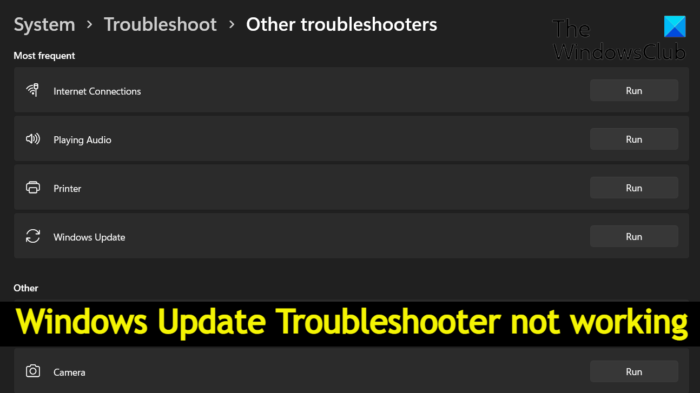Why is Windows Update Troubleshooter not working?
One of the major reasons why Windows Update Troubleshooter is not working on your system is a corrupted user profile or system files. If the Cryptographic Service under the Service Manager is disabled, you will most likely face the problem. The issue can also occur due to temporary files. Now that you have a prior piece of knowledge about different reasons why Windows Update Troubleshooter is not working on your system let’s check out how to eliminate them.
Windows Update Troubleshooter not working
If Windows Update Troubleshooter is taking forever & is stuck on resolving problems or at checking for pending restart, here are some suggestions that will help you: Now, let’s check out all these solutions in detail.
1] Restart the system and check the connection
First, restart your system and check if it solves the problem. As it turns out, a temporary Windows glitch is one of the primary reasons behind the problem. And the best thing you can do in this situation is to restart your system. Additionally, make sure you are connected to an active internet connection. As you must know, Windows Update Troubleshooter requires an internet connection to resolve all the issues related to Windows Update. So, connect your system to an active internet connection and check if it solves the problem.
2] Run System File Checker
As mentioned, the problem is mainly caused due to corrupted system files. In this situation, you can run System File Checker, aka SFC scan, to get rid of the problem. Below are the steps you need to run the SFC scan on Windows 11/10. The process will take around 10-15 minutes, and it will examine all the system files and replace the corrupted ones. Once done, restart your system and try to rerun Windows Update Troubleshooter. Check if the problem is fixed or not. If not, try the next solution.
3] Enable Cryptographic Service
You next thing you should make sure of is that the Cryptographic Service is enabled under the Service Manager. If this isn’t the case, you will most likely face the problem in question. So, here are the steps you need to follow to enable Cryptographic Service. Restart your system and check if you are still facing the problem.
4] Change the Local Group Policy settings
You can configure the Local Group Policy settings to fix the problem as well. Here’s how it’s done. Once done, restart the system and check for the problem. See: How to run Windows Troubleshooters from the command line
5] Login as Administrator
The problem has mainly seemed to occur with users who were not using the Administrator account. So, use Windows Update Troubleshooter when logged on as an administrator user. See: Online troubleshooter to fix Windows Update Errors
6] Run Disk Cleanup
As mentioned, the problem can occur due to temporary files stored on your system. To get rid of the issue you can run Disk Cleanup.
7] Check Log files
The troubleshooting reports, logs & other data are saved in the following locations:
%LocalAppData%\Diagnostics : It contains folders for the previously run troubleshooter.%LocalAppData%\ElevatedDiagnostics : It contains folders for each troubleshooter which was Run as Administrator.Windows Logs/ApplicationApplications and Services Logs/ Microsoft/ Windows/ Diagnosis-Scripted/ AdminApplications and Services Logs/ Microsoft/ Windows/ Diagnosis-ScriptedDiagnosticsProvider/ OperationalApplications and Services Logs/ Microsoft/ Windows/ Diagnosis-Scripted/ Operational
See if anything there helps you. TIP: See this post if you receive An unexpected error has occurred, The troubleshooting wizard can’t continue message with error codes 0x803c010a, 0x80070005, 0x80070490, 0x8000ffff, etc.
How do I manually troubleshooter Windows updates?
It’s very easy to troubleshoot a Windows Update problem manually. To begin with, open the Windows settings, and choose Troubleshoot option present under System. Open Other troubleshooters in the following window. Click on the Run option present next to Windows Update.

